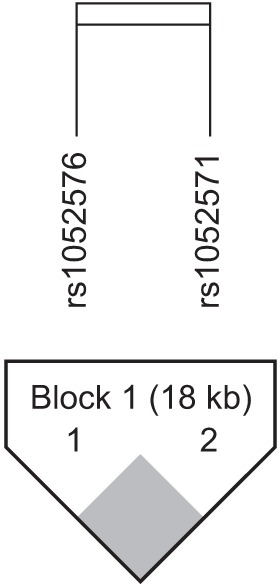Ann Rehabil Med.
2017 Apr;41(2):197-203. 10.5535/arm.2017.41.2.197.
Association Between a Polymorphism in CASP3 and CASP9 Genes and Ischemic Stroke
- Affiliations
-
- 1Department of Rehabilitation Medicine, Kyung Hee University Medical Center, Seoul, Korea. tjg819@hanmail.net
- 2Kohwang Medical Research Institute, Kyung Hee University, Seoul, Korea.
- KMID: 2389476
- DOI: http://doi.org/10.5535/arm.2017.41.2.197
Abstract
OBJECTIVE
To investigate whether the polymorphisms of CASP3 gene (rs4647602, intron A/C and rs1049216, UTR C/T) and CASP9 gene (rs1052576, Gln/Arg G/A and rs1052571, Ser/Val T/C) were associated with the development, and clinical severity of ischemic stroke and functional consequences after stroke.
METHODS
Genomic DNA from 121 ischemic stroke patients and 201 healthy control subjects were extracted, and polymerase chain reaction products were sequenced. To investigate the association of polymorphisms and the development, and National Institutes of Health Stroke Scale (K-NIHSS), logistic regression models were analyzed.
RESULTS
Polymorphism of the untranslational region of CASP3 (rs1049216, UTR C/T) has been associated with the development of ischemic stroke"”in codominant1 model (odds ratio [OR], 0.51; 95% confidence interval [CI], 0.29-0.88; p=0.017), in dominant model (OR, 0.57; 95% CI, 0.34-0.97; p=0.034), and in the overdominant model (OR, 0.50; 95% CI, 0.29-0.87; p=0.011). A missense SNP of CASP9 gene (rs1052571, Ser/Val T/C) was associated with the development of ischemic stroke (OR, 1.93; 95% CI, 1.05-3.55; p=0.034 in recessive model).
CONCLUSION
These results indicate the possibility that CASP3 and CASP9 genes are markers for the development of ischemic stroke.
MeSH Terms
Figure
Reference
-
1. Grysiewicz RA, Thomas K, Pandey DK. Epidemiology of ischemic and hemorrhagic stroke: incidence, prevalence, mortality, and risk factors. Neurol Clin. 2008; 26:871–895. PMID: 19026895.
Article2. Andrawes WF, Bussy C, Belmin J. Prevention of cardiovascular events in elderly people. Drugs Aging. 2005; 22:859–876. PMID: 16245959.
Article3. Gil-Nunez A. The metabolic syndrome and cerebrovascular disease: suspicion and evidence. Cerebrovasc Dis. 2007; 24(Suppl 1):64–75. PMID: 17971640.
Article4. Lanktree MB, Dichgans M, Hegele RA. Advances in genomic analysis of stroke: what have we learned and where are we headed? Stroke. 2010; 41:825–832. PMID: 20167918.5. Shiber JR, Fontane E, Adewale A. Stroke registry: hemorrhagic vs ischemic strokes. Am J Emerg Med. 2010; 28:331–333. PMID: 20223391.
Article6. Burguillos MA, Deierborg T, Kavanagh E, Persson A, Hajji N, Garcia-Quintanilla A, et al. Caspase signalling controls microglia activation and neurotoxicity. Nature. 2011; 472:319–324. PMID: 21389984.
Article7. Nicholson DW, Ali A, Thornberry NA, Vaillancourt JP, Ding CK, Gallant M, et al. Identification and inhibition of the ICE/CED-3 protease necessary for mammalian apoptosis. Nature. 1995; 376:37–43. PMID: 7596430.
Article8. Cohen GM. Caspases: the executioners of apoptosis. Biochem J. 1997; 326(Pt 1):1–16. PMID: 9337844.
Article9. Belhocine T, Steinmetz N, Hustinx R, Bartsch P, Jerusalem G, Seidel L, et al. Increased uptake of the apoptosis-imaging agent (99m)Tc recombinant human Annexin V in human tumors after one course of chemotherapy as a predictor of tumor response and patient prognosis. Clin Cancer Res. 2002; 8:2766–2774. PMID: 12231515.10. Blankenberg FG, Katsikis PD, Tait JF, Davis RE, Naumovski L, Ohtsuki K, et al. In vivo detection and imaging of phosphatidylserine expression during programmed cell death. Proc Natl Acad Sci U S A. 1998; 95:6349–6354. PMID: 9600968.
Article11. Vriens PW, Blankenberg FG, Stoot JH, Ohtsuki K, Berry GJ, Tait JF, et al. The use of technetium Tc 99m annexin V for in vivo imaging of apoptosis during cardiac allograft rejection. J Thorac Cardiovasc Surg. 1998; 116:844–853. PMID: 9806391.
Article12. O'Donnell MJ, Xavier D, Liu L, Zhang H, Chin SL, Rao-Melacini P, et al. Risk factors for ischaemic and intracerebral haemorrhagic stroke in 22 countries (the INTERSTROKE study): a case-control study. Lancet. 2010; 376:112–123. PMID: 20561675.13. Weng WC, Huang WY, Chien YY, Wu CL, Su FC, Hsu HJ, et al. The impact of smoking on the severity of acute ischemic stroke. J Neurol Sci. 2011; 308:94–97. PMID: 21665225.
Article14. Wall JD, Pritchard JK. Haplotype blocks and linkage disequilibrium in the human genome. Nat Rev Genet. 2003; 4:587–597. PMID: 12897771.
Article15. Kuida K, Zheng TS, Na S, Kuan C, Yang D, Karasuyama H, et al. Decreased apoptosis in the brain and premature lethality in CPP32-deficient mice. Nature. 1996; 384:368–372. PMID: 8934524.
Article16. Xu W, Jiang S, Xu Y, Chen B, Li Y, Zong F, et al. A meta-analysis of caspase 9 polymorphisms in promoter and exon sequence on cancer susceptibility. PLoS One. 2012; 7:e37443. PMID: 22616010.
Article17. Le DA, Wu Y, Huang Z, Matsushita K, Plesnila N, Augustinack JC, et al. Caspase activation and neuroprotection in caspase-3-deficient mice after in vivo cerebral ischemia and in vitro oxygen glucose deprivation. Proc Natl Acad Sci U S A. 2002; 99:15188–15193. PMID: 12415117.18. Kerr LE, McGregor AL, Amet LE, Asada T, Spratt C, Allsopp TE, et al. Mice overexpressing human caspase 3 appear phenotypically normal but exhibit increased apoptosis and larger lesion volumes in response to transient focal cerebral ischaemia. Cell Death Differ. 2004; 11:1102–1111. PMID: 15153940.
Article19. Kuida K, Haydar TF, Kuan CY, Gu Y, Taya C, Karasuyama H, et al. Reduced apoptosis and cytochrome c-mediated caspase activation in mice lacking caspase 9. Cell. 1998; 94:325–337. PMID: 9708735.
Article20. Akpan N. The intrinsic caspase death pathway in stroke neurodegeneration [dissertation]. New York: Columbia University;2013.
- Full Text Links
- Actions
-
Cited
- CITED
-
- Close
- Share
- Similar articles
-
- Lack of Association between Angiotensinogen M235T Gene Polymorphism and Ischemic Stroke in Korean
- Association between Beta Adrenergic Receptor Polymorphism and Ischemic Stroke: A Meta-Analysis
- MTHFR A1298C Gene Polymorphism: Independent Risk Factor for Ischemic Stroke?
- Association of the Adiponectin Gene Variations with Risk of Ischemic Stroke in a Korean Population
- beta-Fibrinogen Gene -455 G/A Polymorphism in Korean Ischemic Stroke Patients



